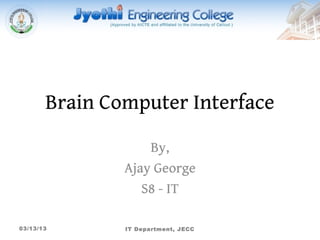Brain Computer Interface ppt
- 1. Brain Computer Interface By, Ajay George S8 - IT 03/13/13 IT Department, JECC
- 2. What is BCI âĒ Direct communication pathway between the brain and an external device âĒ Reads electrical signals from brain âĒ Signals translated into a digital form 03/13/13 IT Department, JECC
- 3. History âĒ Research started from 1970 âĒ BCI Project by Jacques Vidal âĒ Implanting simple BCI sensors within rats, mice, monkeys, and humans. 03/13/13 IT Department, JECC
- 4. History âĒ 1990 - implanting an electrode in the motor cortex of a paralyzed patient. âĒ Makes the patient communicate by moving a cursor. âĒ 1999 â Trained rats to use their brain signals to move a robotic water-dispensing arm. 03/13/13 IT Department, JECC
- 5. How BCI work 03/13/13 IT Department, JECC
- 6. How BCI work 03/13/13 IT Department, JECC
- 7. How BCI work âĒ Uses optical nerves for image input âĒ Camera input directed to brain 03/13/13 IT Department, JECC
- 8. Types of BCI âĒ Invasive âĒ Partially Invasive âĒ Non-Invasive 03/13/13 IT Department, JECC
- 9. Invasive BCI âĒ Targeted for people with paralysis âĒ Implanted directly into the grey matter âĒ Produce the highest quality signals Jens Naumann, a man with acquired blindness, being âĒ scar-tissue build-up interviewed about his vision 03/13/13 IT Department, JECC
- 10. Partially Invasive BCI âĒ BCI devices are implanted inside the skull âĒ produce better resolution signals Cathy Hutchinson, who was one âĒ lower risk of of the first persons to have a forming scar-tissue direct connection between her brain and a computer implanted 03/13/13 IT Department, JECC
- 11. Non-Invasive BCI âĒ Easy to wear âĒ produce poor signal âĒ dispersing the electromagnetic waves created by the neurons 03/13/13 IT Department, JECC
- 12. Recording Domains 03/13/13 IT Department, JECC
- 13. Electrocorticography(ECoG ) âĒ Pioneered in the early 1950s âĒ Measures the electrical activity of the brain âĒ Taken from beneath the skull âĒ Embeds electrodes in a plastic bag placed above cortex âĒ A surgical incision is required 03/13/13 IT Department, JECC
- 14. MRI technology âĒ Uses brain signals to control âĒ Detects the subjectâs brain signals and sends the MRI signals over Ethernet cables, via TCP/IP, to a computer. 03/13/13 IT Department, JECC
- 15. MRI technology 03/13/13 IT Department, JECC
- 16. Magnetoencephalography (MEG) âĒ Magnetic Field of 10-15 T to 10-13 T âĒ S.Q.U.I.D Sensors are required âĒ Shielded room is needed 03/13/13 IT Department, JECC
- 17. Electroencephalography (EEG) âĒ Recording of electrical activity along the scalp âĒ Measures voltage fluctuations resulting from ionic current. âĒ Fine temporal resolution âĒ Ease of use, portable and low set-up cost 03/13/13 IT Department, JECC
- 18. Electroencephalography (EEG) Emotiv Cap, 14 Electordes, Wireless connection. Commercial BCI from NeuroSky 03/13/13 IT Department, JECC
- 19. Electroencephalography (EEG) P300 03/13/13 IT Department, JECC
- 20. Electroencephalography (EEG) âĒ Described in frequency ranges âĒ Delta (Îī) < 4 Hz. Most apparent in deep sleep states. âĒ Theta (Îļ) waves 4-8 Hz, appear in a relaxed state and during light sleep and meditation. 03/13/13 IT Department, JECC
- 21. Electroencephalography (EEG) âĒ Alpha (Îą) waves 8-12 Hz, associated with meditation and relaxation. âĒ Beta (Îē) 13-30 Hz waves, connected to alertness and focus. âĒ Gamma (Îģ) waves > 30 Hz, related to subjective awareness 03/13/13 IT Department, JECC
- 22. Electroencephalography (EEG) System Block Diagram 03/13/13 IT Department, JECC
- 23. Processes âĒ Bandpass Filter - to filter out frequencies that do not fall within the Îą and Îē ranges. âĒ Related to senseorimotor activities âĒ Common Spatial Patterns (CSP) â enhances the discriminability between classes. 03/13/13 IT Department, JECC
- 24. Processes Feature Extraction methods used to collect useful vectors âĒ Log Variance âĒ Power Density Estimation (PSD) âĒ Wavelet Packet Decomposition (WPD) 03/13/13 IT Department, JECC
- 25. Processes âĒ Principle Component Analysis (PCA) -reduce the dimensionality of the feature vector âĒ Classification Method - to build classifier which discriminate between labels. Linear Discriminant Analysis (LDA) is used 03/13/13 IT Department, JECC
- 26. Electroencephalography (EEG) 03/13/13 IT Department, JECC
- 27. Applications âĒ Medicinal âĒ Military âĒ Bioengineering âĒ Brain operated wheelchair âĒ Multimedia and Virtual Reality 03/13/13 IT Department, JECC
- 28. Conclusion âĒ Enables people to communicate and control appliances with use of brain signals âĒ Open gates for disabled people. âĒ Development of new brain imagining techniques âĒ Numerous future applications 03/13/13 IT Department, JECC
- 29. Bibliography âĒ Toward Inexpensive and Practical Brain Computer Interface by Hamzah S. AlZuâbi Nayel S. Al-Zubi Waleed Al-Nuaimy âĒ Robot Navigation using Brain-Computer Interfaces by Athanasios Vourvopoulos and Fotis Liarokapis 03/13/13 IT Department, JECC
- 30. Bibliography âĒ A general framework of Brain-Computer Interface with Visualization and Virtual Reality Feedback by Gufei Sun, Kuangda Li, Xiaoqiang Li, Bofeng Zhang, Shizhong Yuan, Gengfeng Wu 03/13/13 IT Department, JECC
- 31. Thank You 03/13/13 IT Department, JECC































